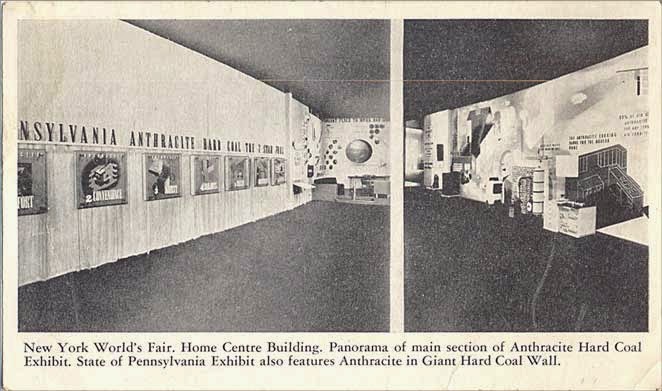 | ||||
| New York World's Fair State of Pennsylvania Replica of Independence Hall housing Giant Anthracite Wall |
 |
| New York World's Fair Giant Anthracite Hard Coal Wall in the State of Pennsylvania Exhibit |
 |
| New York World's Fair Anthracite Hard Coal Exhibit in Home Centre Building |
 |
| New York World's Fair Automatic Anthracite Stokers for home heating in Home Centre Building |
The four postcards above are from the State of Pennsylvania exhibits at the 1939-1940 New Work World's Fair. The exhibits featured Anthracite Coal, an important Pennsylvania product. Anthracite is a hard coal that differs from ordinary bituminous coal by its greater hardness, its higher relative density, and luster.
Here are some facts about Anthracite formation gleaned from the subtitles on a 1920s silent film video, Anthracite Coal Mining circa 1920 (this video is informative but somewhat tedious):
- Different from bituminous, which occurs in level beds, anthracite is found in folded and twisted strata.
- The coal beds are but the remains of ancient forests.
- As the dense vegetation decayed it made a carpet of humus hundreds of feet thick.
- The land sank and water covered the remains of the forest. Silt and sand slowly settled down.
- Tremendous pressure from above packed the mass, and it became coal.
- At first the coal was soft, or bituminous.
- At some time in that distant past a great earthquake twisted and folded this Pennsylvania plain.
- The great heat and immense pressures, due to this disturbance, changed the soft coal into Anthracite
The How Coal Mines Work: "Mining and Preparation of Anthracite Coal" video below shows the anthracite mining process in the 1930s..
This Pennsylvania Anthracite Coal Mining video shows 1920s Pennsylvania coal miners at work.
CELEBRATE THE 75TH ANNIVERSARY OF THE 1939-40 WORLD'S FAIRS
In New York and San Francisco
Look for more World's Fair Postcards on the Postcardy Blog on Fridays.
To view past World's Fair posts, click here or on the exposition label.
Visit Sepia Saturday
for More Vintage Images










The 1920s video of PA coal miners is fantastic. I thought I'd watch a couple minutes to get the idea, but I couldn't stop watching. That is some real physical labor. Dangerous and tedious both. I'm grateful to those willing to do it.
ReplyDeleteAn anthracite wall? Really? But, like Wendy, I got hooked on the videos!
ReplyDeleteThe difference between the two videos brought a smile. A 'silent', & a 'talkie'! Both were fun to watch. I find it interesting that the newer Glen Alden Mine video left out the part where they dyed their anthracite coal blue so it was recognizable from anthracite mined by other companies, making it possible for them to market their product as "Blue Coal". The video was dated c.1934. Perhaps the Glen Alden company didn't start dying their coal until after their newer breaker building was built in 1938? I would like to have seen that anthracite wall. Must have been something!
ReplyDeleteYou never fail to come with tremendous postcards right on theme. Are they all from your own collection?
ReplyDeleteThey are all from my own collection.
DeleteI'm sure I saw that video in elementary school - or was the music and voice-over the same in all of them? My job at home was to remove the ashes from the furnace and pile them behind our garage where they were either picked up or used by people preparing to back their cars out of their garages on ice and snow. I was so happy when we converted to an oil furnace and my career as an ash carrier came to an end. The first job I lost to better technology.
ReplyDeleteLoved the narration of the first video - specifically how the coal is "eager to do man's bidding in homes..."!
ReplyDeleteThrough your inspiration, I am now on the lookout for more World's Fair postcards.
I think in Australia they only mine two types of coal, black and brown. That 1920s film shows just what dangerous and dirty work mining is, and I felt so sorry for the poor pit pony - I bet he didn't have a long life, and the coal dust didn't do the miners any good either, assuming they were lucky enough to escape mining disasters that were not uncommon.
ReplyDeleteYour New York State Fair postcards seem able to provide ‘fuel’ for your blogposts for may years to come!
ReplyDeleteI remember taking out some ashes that still had live sparks. Luckily it was found before any damage was done and from then on they went into a metal container.
ReplyDeleteUmm, umm, ummm, Coal, it's what's for dinner!
ReplyDeleteThanks for the link on the new military field kitchen. I liked how it was "improved" so that the kitchen didn't get so hot as to disable the cook's cell phones!
So glad to learn about this historic stuff, coal mining. Someday it will only be a memory.
ReplyDelete